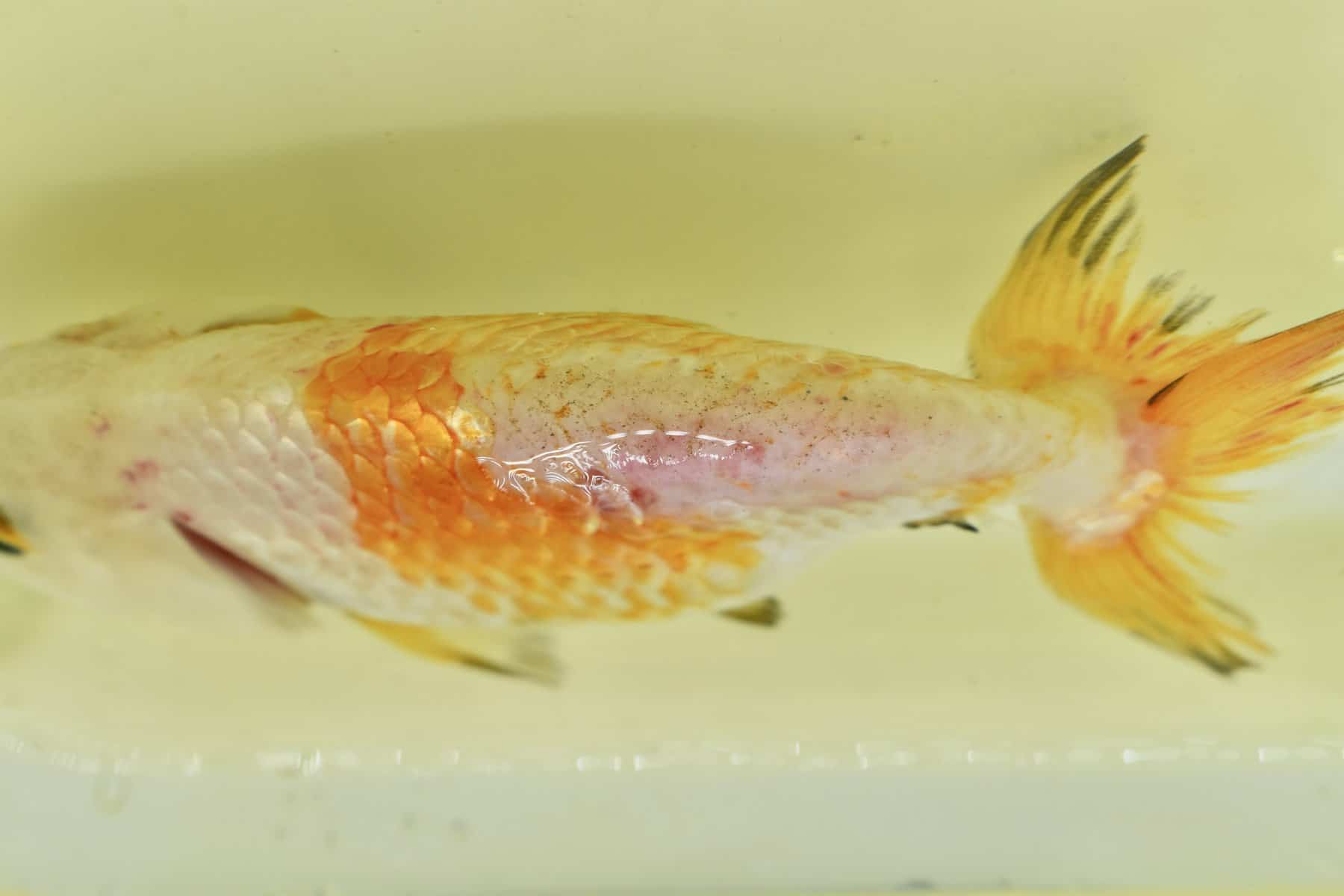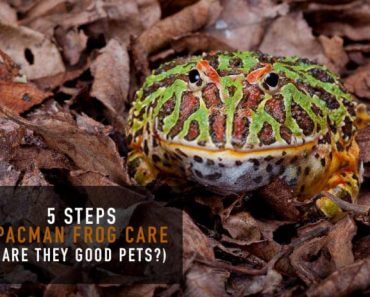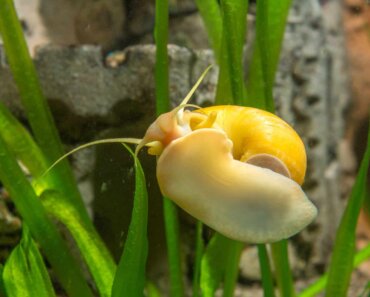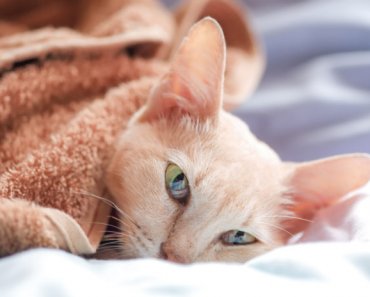A healthy goldfish shouldn’t lose its scales or skin. So you know that if your pet’s appearance changes and he begins losing scales, turning white, or his skin starts peeling off, there’s a serious problem.
Peeling skin and lost goldfish scales can be caused by several things, including bacterial infections, poor water quality, low levels of dissolved oxygen, or attacks by skin parasites or flukes. The problem could even be due to bullying and nipping by other fish.
In this guide, we take a closer look at the reasons that could be responsible for your goldfish’s peeling skin.
Do Goldfish Lose Their Scales and Skin Routinely?
Unlike snakes and other reptiles, goldfish do not routinely shed their skin and scales. So, if you spot your fish’s skin peeling, that’s not normal.
Generally, peeling skin and shed scales are a sign that you have an injured or sick fish, and you need to take action!
Poor Slime Coat
One reason why your fish might be suffering from peeling skin, lost scales, and a white appearance is that its slime coating is poor. The slime coating is basically a glycoprotein layer that coats the fish’s skin to protect it from parasites, pollution, and bacteria.
When the water conditions are poor, and the fish is exposed to excess ammonia, insufficient dissolved oxygen, incorrect temperatures, or pH levels, the slime coat is weakened, leaving the goldfish exposed to attack from diseases.
Restorative Action
To restore the slime coat, start by removing the affected goldfish from your main display tank and putting it into a quarantine tank.
The water parameters in your quarantine tank must be correct. So, the water temperature should be between 62o and 71o Fahrenheit with a pH level in the range of 7.2 to 8.0. Ammonia and nitrite levels must be zero, with nitrates below 20 ppm.
Feed the fish a high-quality, varied diet and a multivitamin supplement. It’s also recommended to add an anti-bacterial treatment and water conditioner to the tank.
That treatment will help to restore the fish’s slime coat, and you should see an improvement in your pet’s overall condition, skin, and scales.
Physical Trauma
Goldfish can sustain external injuries from physical trauma in various ways. Perhaps the fish has collided with a tank decoration or even bumped into the viewing panes during a feeding frenzy.
My goldfish would sometimes rub against hard surfaces in the tank, such as the substrate, a piece of driftwood, or a rock, removing a scale or two in the process.
If you have Fancy goldfish, they are terrible swimmers, wobbling around the tank and frequently crashing into things. You can help keep your fish out of trouble by choosing smooth decorations that won’t damage your fish and leaving plenty of clear swimming space.
In contrast, all the long-bodied goldfish species are excellent swimmers, so again, you must leave the center of the tank clear of obstructions to prevent accidents.
Of course, regardless of what fish you keep, you should never overcrowd your tank. Overcrowded tanks are notoriously fraught with problems for the pet parent, including injuries to their fish and poor water quality.
Rough Handling
Many goldfish are injured or damaged through incorrect or rough handling, either when being netted or manually grabbed during transfer between tanks.
Although goldfish are pretty hardy characters, you must handle them carefully, as their skin is delicate and easily damaged. Don’t pick your fish up with your hands unless there’s an emergency and you don’t have a net handy.
I once had two very large Fancy goldfish that hated being netted. In their case, I found it much less stressful for the fish to gently scoop them up in a plastic jug on the odd occasion when I needed to remove them from their tank.
Parasites

Parasites can cause a goldfish to lose its scales or suffer from peeling skin. Several types of common fish parasites can attack goldfish of all varieties, including the following:
Ich
Ichthyophthirius multifiliis is an aquatic protozoan parasite that attacks almost every species of freshwater fish, including goldfish.
These parasites are present in most healthy fish tanks, only attacking fish that are already sick or weakened by stress.
The Ich parasite has a complex lifecycle. Usually, the first sign of an infection is when your goldfish starts flicking or flashing against solid objects within the tank, including the substrate. That’s because the parasite burrows into the fish’s skin, causing intense irritation, so the fish rub themselves against things to try to relieve the itchiness the parasites cause.
After a few days, you’ll notice a few tiny white spots appearing on the fish’s skin, gills, and fins, which confirms your goldfish have Ich or White Spot disease.
Fortunately, you can treat Ich relatively easily by raising the water temperature to 82o Fahrenheit for three days and treating the tank with an Ich medication that you’ll get from your local fish store.
Anchor Worms
Anchor worms are not actually worms, but copepod parasites that fix themselves to the fish’s skin, leaving a worm-like tail protruding from the skin. In fact, the “worm” you can see with your naked eye is the female parasite’s reproductive structure.
Juvenile worms are free-swimming in the fish tank but won’t trouble your fish until they reach adulthood.
The parasites irritate the goldfish’s skin so that the creature rubs or flicks against solid objects in the tank, often removing fish scales or damaging its skin in the process.
You can treat Anchor worms by adding an over-the-counter treatment to your tank, following the manufacturer’s directions carefully.
Flukes
Flukes is an umbrella term that’s generally used to describe numerous species of macroparasites you’ll sometimes see attached to your goldfish’s skin or gills. Again, those parasites irritate the fish, causing it to rub against things in the tank in an attempt to get rid of them.
Flukes can be killed by treating the water with a suitable anti-parasitic medication that you’ll get from your vet or a good fish store.
Fungus
Fungal infections present as white fluffy growths, typically around the fish’s head, mouth, and sometimes at the base of its fins.
Fungus is usually caused by keeping the fish in poor water conditions, so you need to take a close look at the cleanliness of your fish tank and the water parameters if your goldfish develops fungus.
Although fungus doesn’t cause scale loss or peeling skin, it will make the fish lose its color and turn milky white in patches.
To get rid of the fungus, treat the water with an antifungal medication, and give your tank a thorough clean! Check that the water parameters are correct, and renew your filter media if required.
Bacterial Infections
Goldfish can be attacked by bacterial infections, which can cause scale loss and sometimes result in your fish’s skin peeling off.
Many different species of bacteria attack goldfish, and the symptoms of bacterial infections are many and varied. However, sometimes, the bacteria enter the fish’s body through a physical injury, setting up an infection under the skin that can cause red patches, ulcers, and skin loss.
To treat bacterial infections, use an over-the-counter product, following the manufacturer’s directions carefully.
Aggressive Tank Mates
Goldfish are peaceful creatures that are not known to be aggressive toward each other or other fish. That’s great if you have a peaceful community setup, but it does leave the fish vulnerable to attack by more belligerent types.
Fancy goldfish are especially susceptible to injury through interaction with tank mates because they are slow swimmers that can easily be bullied, especially at feeding times. However, fast swimmers can get involved in bumping and barging matches at meal times or simply collide with each other, causing injuries.
The simplest solution is to remove any semi-aggressive fish from your setup and rehome them with friends or through your local pet store. I recommend keeping slim-bodied fish in ponds rather than tanks, as they usually grow too big for most home aquariums.
In addition, don’t mix slim-bodied goldfish, such as Comets and Shubunkins, with Fancies to avoid accidents and a competition for food that the Fancy goldfish will never win.
Does Peeling Goldfish Skin Grow Back?
Fortunately, lost scales and damaged skin do grow back eventually. Generally, skin and scales take between a couple of weeks and several months to regrow completely.
One of my goldfish once lost a large body scale, and I feared infection would set in. Fortunately, the fish was fine, and the scale did grow back within about three months.
When your fish has sustained an injury, it’s crucial to treat the fish appropriately to prevent a secondary bacterial infection from developing, which could kill your fish.
Final Thoughts
Did you enjoy our article explaining why your goldfish’s skin might appear to be peeling off? If you found the information helpful, please remember to share the guide!
There are several reasons why your fish might start losing scales and skin. The most likely culprit is some kind of bacterial disease that attacks the fish’s skin. Physical trauma can also be to blame following an attack by another fish or rough handling.
You can help to protect your goldfish from peeling skin and scale loss by taking steps to improve the condition of its slime coat.
Did your goldfish’s scales grow back after losing them? Tell us in the comments box below.


























